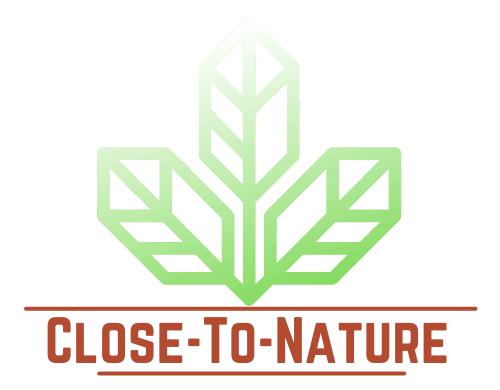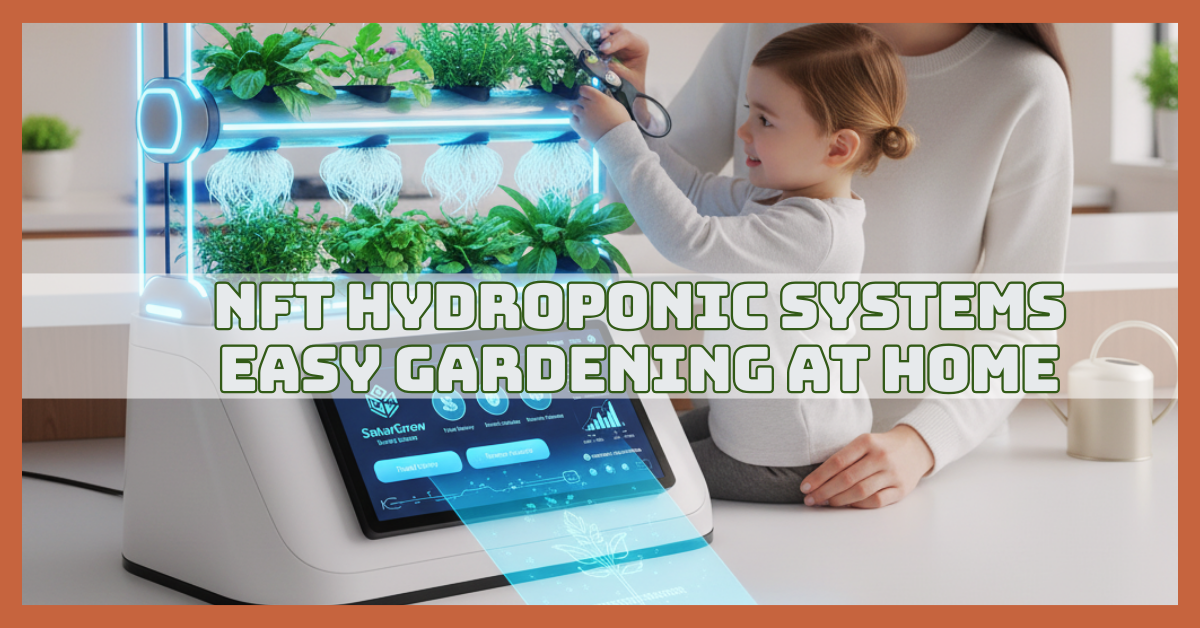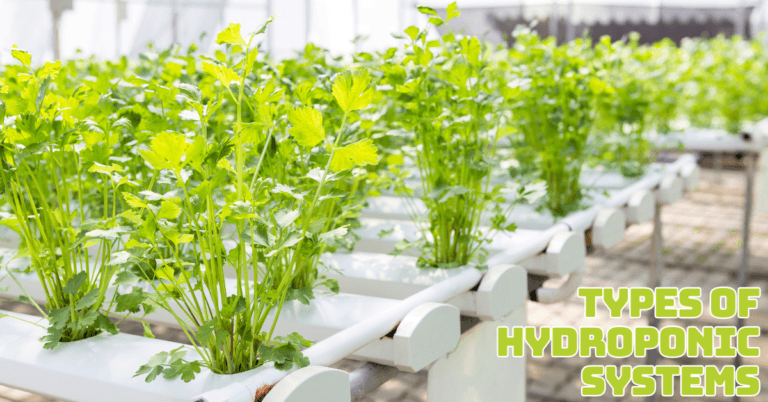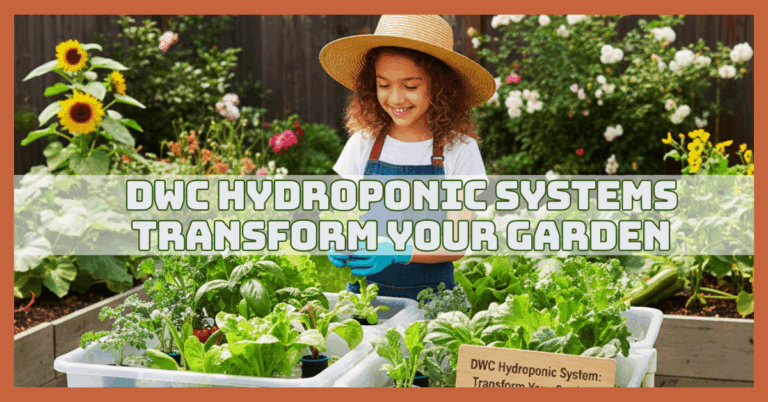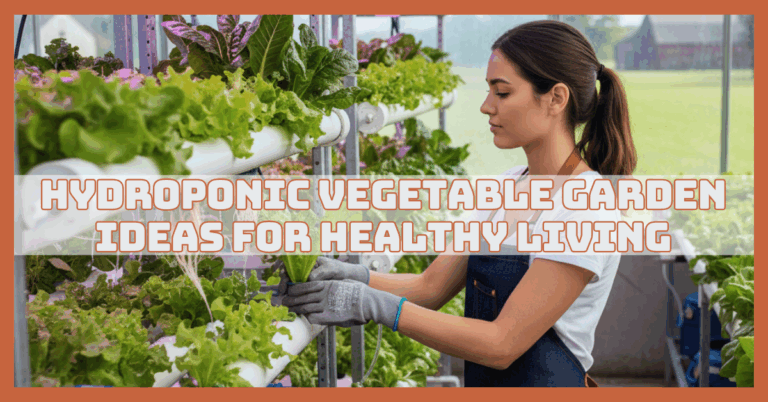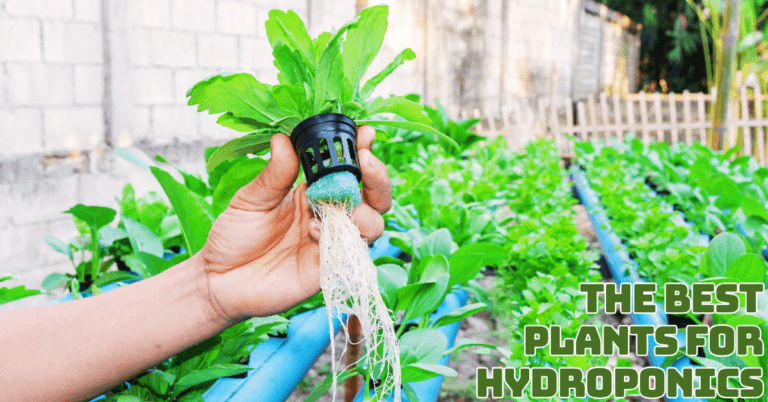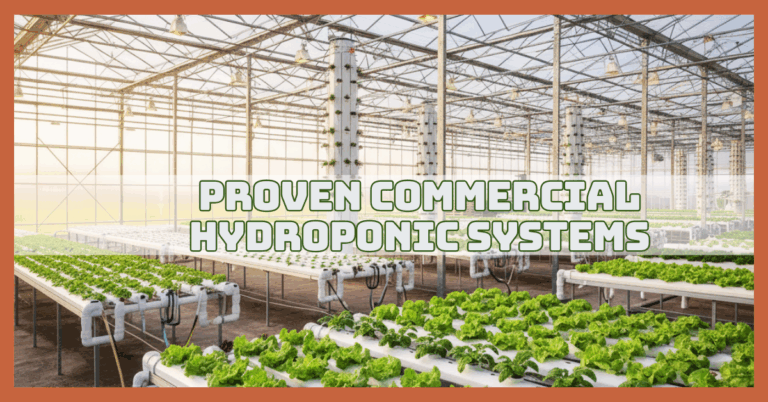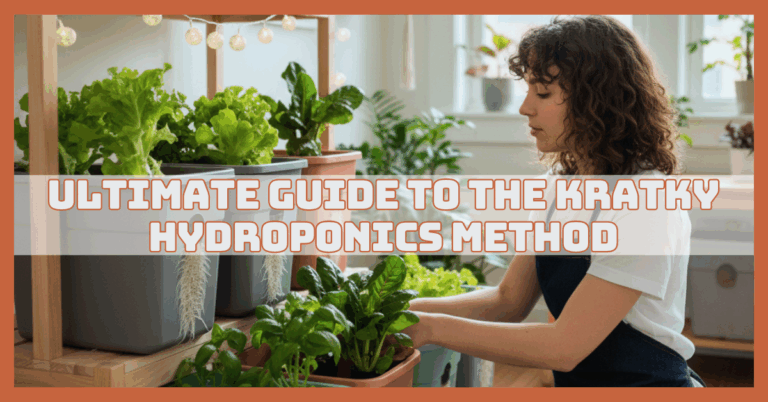NFT Hydroponic Systems: Easy Gardening At Home
Hydroponics has transformed the way we grow food. Among all methods, the NFT Hydroponic Systems (Nutrient Film Technique) stand out for their efficiency, simplicity, and ability to grow crops in limited space.
Instead of soil, plants sit in channels where a thin film of nutrient-rich water constantly flows past their roots. This keeps them fed, oxygenated, and growing faster than traditional farming.
In this blog, we will explore the types of NFT Hydroponic Systems, how much they cost, their pros and cons, and finally, an in-depth step-by-step growing process with the best crops suited for NFT.
By the end, you’ll know exactly how to start your own NFT system and grow fresh vegetables and herbs year-round.
Types of NFT Hydroponic Systems
1. Standard NFT System
The standard NFT system works best in moderate climates between 60 and 80°F, making it ideal for temperate growing zones or controlled indoor spaces.
Costing is relatively low, with small home setups starting at $150 to $300, while larger DIY projects may reach $500, making it budget-friendly.
Setup Process
To set up a standard NFT system, position a reservoir beneath slightly sloped PVC pipes fitted with evenly spaced net pot holes. Install a submersible pump inside the reservoir and connect it to the top of the channels with tubing.
The pump delivers the nutrient solution, which flows in a thin film along the roots and drains back into the reservoir by gravity. Add an air pump with airstones to oxygenate the solution.
Place seedlings started in rockwool cubes into the net pots. Secure the structure to avoid leaks, and test water flow before planting to ensure smooth circulation.
Growing Process
To begin, place a reservoir beneath sloped PVC channels fitted with net pot holes. A submersible pump circulates the nutrient solution, creating a thin film that flows past plant roots before returning to the reservoir by gravity.
Seedlings are first germinated in rockwool cubes before being transferred to the system. Daily monitoring of pH and nutrient strength is essential, with complete solution replacement every 10 to 14 days.
Within 30 to 45 days, leafy greens reach harvest size, and the cycle can be repeated continuously for fresh produce throughout the year.
Best Crops
Lettuce, spinach, basil, cilantro, arugula, kale, mint.
Pros
The standard NFT system is cost-effective, simple to build, and requires little space, making it perfect for home growers. It saves water and nutrients while ensuring steady plant growth.
Leafy greens proliferate, and the system can easily be expanded for higher yields without requiring complicated modifications or advanced skills.
Cons
This system heavily depends on electricity, so that a pump failure can dry roots within hours. It does not support large fruiting plants with heavy roots.
Narrow pipes may clog if not cleaned regularly, and growers must constantly monitor pH, nutrients, and water flow to prevent plant stress or reduced yields.
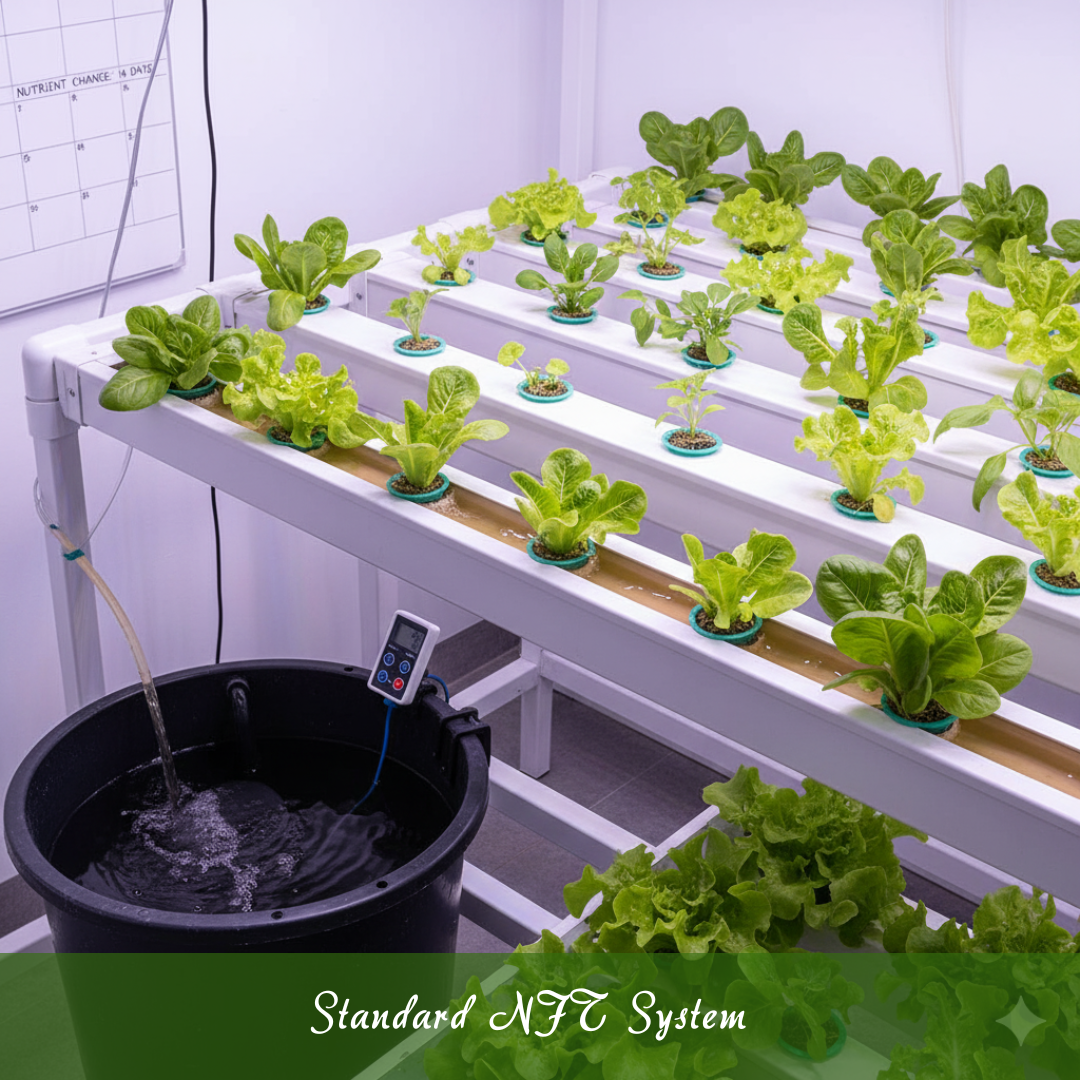
2. Gully NFT System
The gully NFT system is ideal for commercial or larger-scale setups and works best in moderate to warm climates, between 65 and 85°F.
Wider and shallower than standard pipes, the channels allow roots to spread and reduce clogging. Costs start around $800 for small commercial setups and can reach $2,000 or more for advanced systems.
Setup Process
Begin by installing rectangular gullies on a slight slope so the nutrient solution flows evenly along the bottom. Position a reservoir beneath the lowest gully and connect it to a submersible pump that sends solution to the upper end of each gully.
Fit holes for net pots at regular intervals across the channels. Place an air pump in the reservoir for oxygenation. Use food-grade piping to return solution from gullies to the reservoir.
Install support frames to hold the wide channels securely in place. Test water flow before planting to ensure smooth, even distribution across all channels without pooling.
Growing Process
Set up rectangular gullies slightly sloped so nutrient solution flows evenly along the bottom. Place a reservoir below the channels and connect a pump to circulate nutrients.
Seedlings are started in rockwool or other inert media and then placed into the gully holes. The nutrient film continuously nourishes roots while oxygen remains available.
Daily monitoring ensures pH remains around 5.5–6.5 and EC stays within recommended ranges. Channels are cleaned regularly to prevent algae and clogging.
Leafy greens mature in 35 to 50 days, and harvesting can begin once leaves are fully developed. Regular checks maintain consistent growth and high yields.
Best Crops
Lettuce, kale, bok choy, spinach, swiss chard, basil, cilantro.
Pros
The gully NFT system offers better root space, which reduces clogging and improves nutrient absorption. It is long-lasting, cleans up easily, and gives leafy greens consistent development.
The system is suitable for continuous production, increases yield, and ensures healthier plants. It is reliable, efficient, and ideal for commercial and professional growers.
Cons
Gully systems are more expensive than standard setups and require careful installation. They need consistent monitoring of water flow, pH, and nutrient levels.
If neglected, algae growth or disease can occur. The wider channels take up more space, and heavy-rooted plants are still unsuitable. Electricity dependence remains a critical vulnerability.
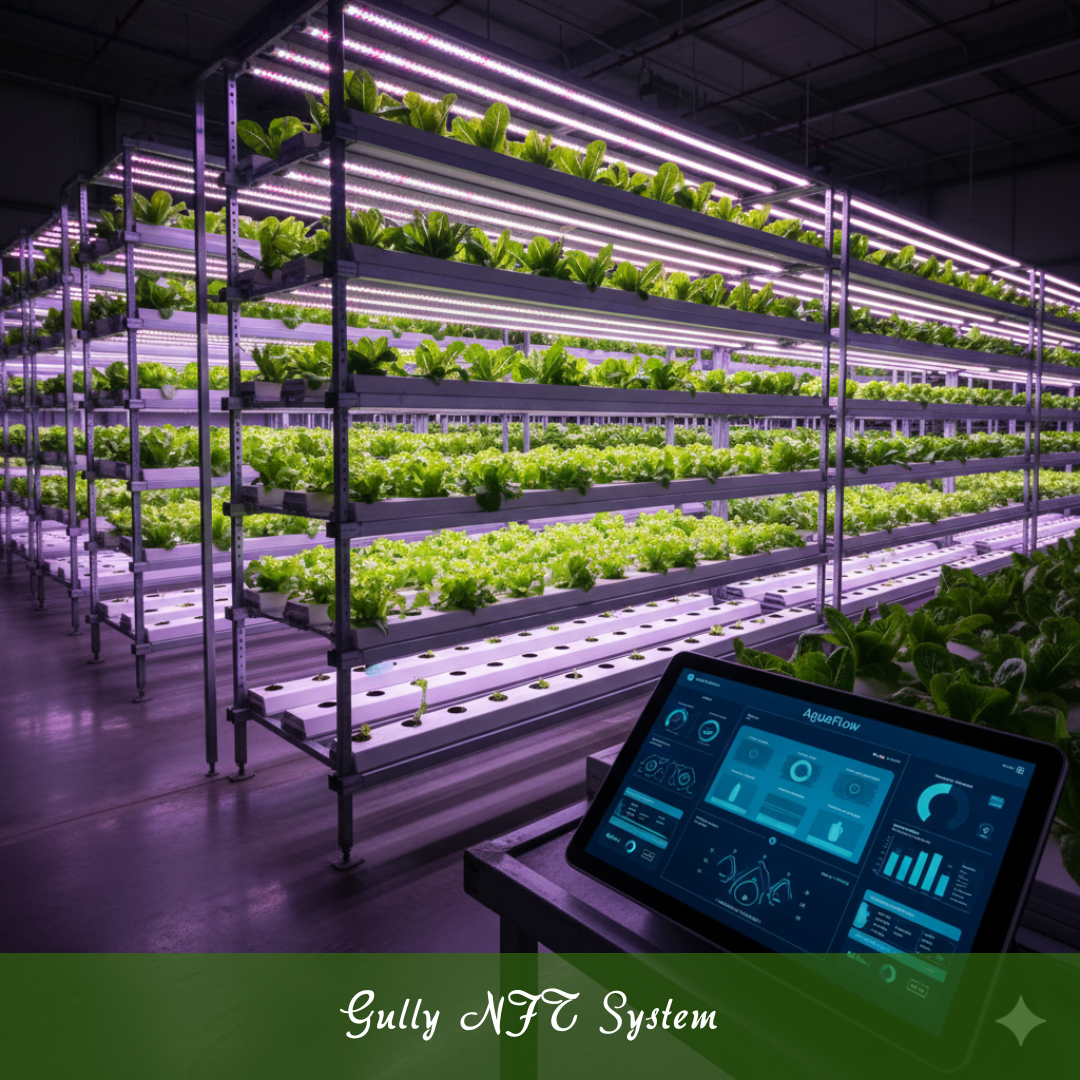
3. Multi-Tier NFT System
The multi-tier NFT system is perfect for growers with limited horizontal space but vertical room, making it ideal for urban or indoor farms.
It performs best in controlled climates between 65 and 80°F. Costs range from $1,000 for small home setups to $10,000 or more for fully automated multi-level systems with lighting and climate control.
Setup Process
Start by building a strong vertical rack or shelving unit to support multiple tiers of NFT channels. Arrange each channel at a slight slope, stacked one above the other, to allow nutrient solution to flow downward tier by tier.
Place a large reservoir under the bottom tier and connect a powerful submersible pump to deliver the solution to the top channel. Install tubing to connect each tier so the solution drains downward and returns to the reservoir.
Add an air pump with airstones to keep nutrients oxygenated. Ensure intense lighting, especially for lower tiers, and test circulation before transplanting seedlings.
Growing Process
Begin by stacking NFT channels vertically with a slight slope to ensure nutrient solution flows smoothly from the top to the bottom. Place a reservoir beneath the lowest tier and connect a submersible pump to feed the top channels.
Seedlings are started in inert media such as rockwool or clay pebbles, then transplanted into the net pots in each tier. Nutrient solution continuously bathes the roots, while oxygenation prevents stagnation.
Daily monitoring of pH and EC ensures optimal nutrient uptake. Regular inspection of flow and lighting guarantees uniform growth. It takes 30 to 45 days to harvest leafy greens and herbs, and output can be sustained through repeated cycles.
Best Crops
Lettuce, spinach, basil, arugula, kale, watercress, and mint.
Pros
The multi-tier NFT system maximizes space by stacking channels vertically, increasing yield per square foot. It supports fast-growing, shallow-rooted crops and allows continuous harvesting.
The design is efficient, adaptable for urban farming, and enables better management of nutrients and water. It is scalable and ideal for intensive, high-density growing.
Cons
Multi-tier setups are more complex and expensive than single-level systems. They require careful attention to water flow, pump capacity, and nutrient distribution across all tiers.
Lower layers may receive less light, so additional lighting is often necessary. System failure or clogging at any level can impact multiple crops, demanding regular monitoring.
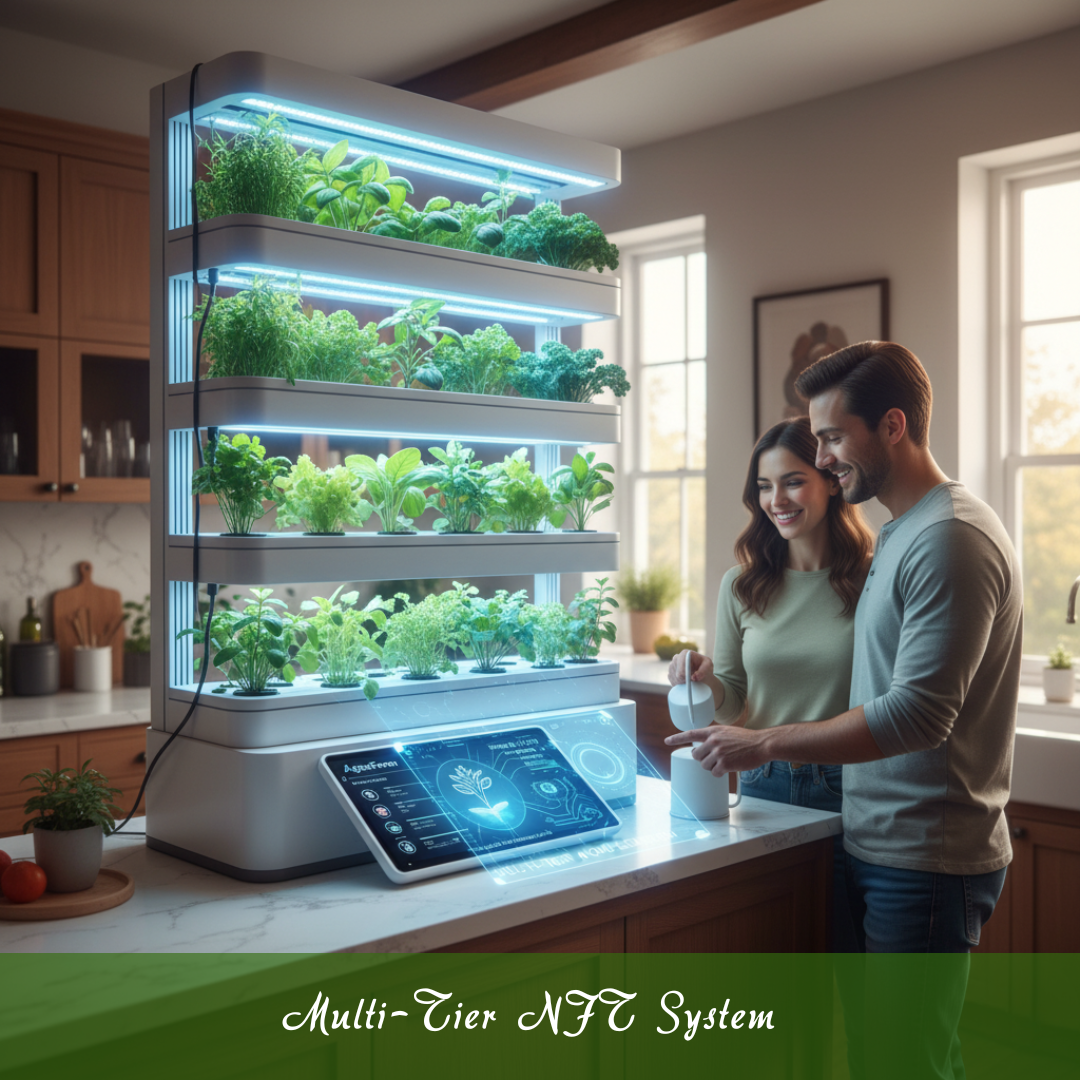
4. Modular NFT System
NFT hydroponic systems offer modular designs that allow independent crop growth, making them ideal for flexible and small-scale setups. Each module operates independently, allowing multiple crops in one setup.
It thrives in moderate climates between 60 and 80°F and is suitable for indoor or small greenhouse conditions. Costs start at $300 for hobby systems and can reach $1,500 for larger modular arrangements.
Setup Process
To set up a modular NFT system, prepare several independent channels or trays, each with a slight slope for nutrient flow. Place a central reservoir beneath the modules and connect each one to the reservoir with tubing.
Install submersible pumps or flow-dividers to distribute the solution to each module. Fit net pot holes across all channels for planting. Add an air pump with airstones to oxygenate the nutrient solution.
Arrange the modules in a compact but accessible layout, allowing easy maintenance. Test flow in each unit to ensure uniform circulation and drainage back to the reservoir before adding seedlings.
Growing Process
Set up multiple small channels or trays connected to a central nutrient reservoir. Ensure each module is slightly sloped so the nutrient solution flows steadily across the roots and returns to the reservoir.
Seedlings are germinated in rockwool, perlite, or clay pebbles before being placed in net pots in each module. The thin nutrient film continuously nourishes roots while providing oxygen. Check pH daily to maintain 5.5–6.5 and adjust EC for specific crops.
Clean modules regularly to prevent algae and blockages. Each module can run independently for continuous cycles, and leafy greens and herbs can be harvested in 30 to 45 days.
Best Crops
Lettuce, spinach, basil, cilantro, arugula, mint, strawberries.
Pros
The modular NFT system allows growers to cultivate different crops simultaneously without affecting other modules. It is portable, easy to rearrange, and ideal for experimentation or crop rotation.
Maintenance is simpler because issues in one module do not spread. The system is educational, versatile, and encourages crop diversity while remaining efficient and manageable.
Cons
Building multiple modules can be more expensive than a single continuous system. It requires careful management of water flow and nutrient balance across each unit.
Modules may occupy more total space, and heavy-rooted plants remain unsuitable. Regular monitoring is essential to avoid nutrient deficiencies, clogging, or algae buildup in any module.
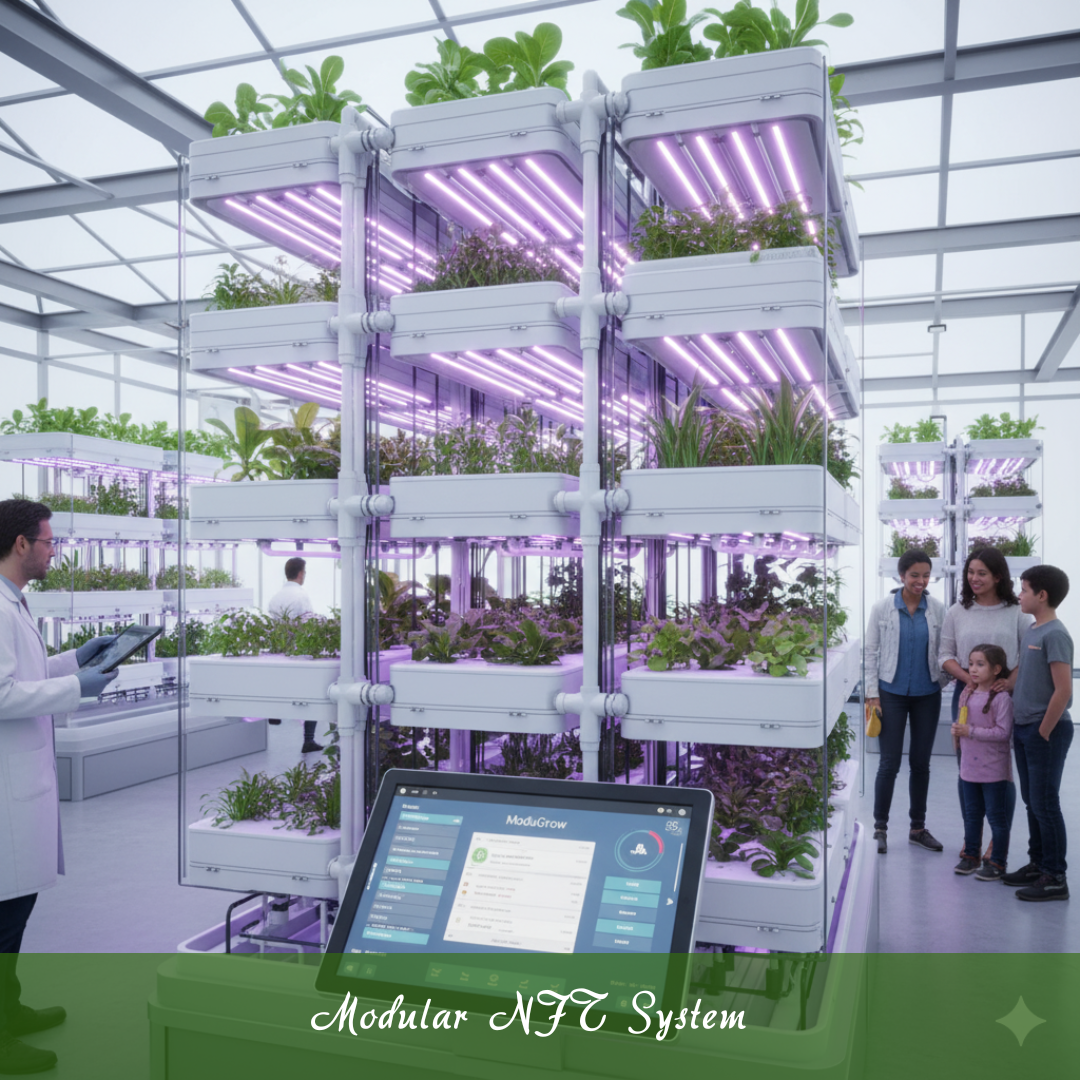
5. Floating NFT System
The floating NFT system is ideal for small-scale setups or hobby growers. It thrives in moderate climates between 60 and 80°F, where temperature control is easier.
The system uses shallow reservoirs with floating rafts or platforms that support seedlings while their roots hang in a thin nutrient layer. Costs are low, starting around $100–$250, making it beginner-friendly and easy to implement at home.
Setup Process
To build a floating NFT system, prepare a shallow reservoir made of food-safe plastic or lined wood to hold nutrient solution. Cut floating rafts or Styrofoam boards to fit the reservoir, drilling evenly spaced holes for net pots.
Insert seedlings in rockwool or similar media into the holes so roots dangle into the thin nutrient layer. Install a small submersible pump with an air stone or bubbler to circulate and oxygenate the water.
Ensure the reservoir is level to maintain even nutrient contact. Test for smooth circulation and adjust raft buoyancy before placing all seedlings for uniform growth.
Growing Process
Fill a shallow reservoir with nutrient solution and place floating rafts or boards on top. Germinate seedlings in rockwool or similar inert media and insert them into holes in the rafts.
Ensure roots are submerged in the thin nutrient film. Monitor pH daily, keeping it between 5.5 and 6.5, and adjust nutrient strength regularly.
Clean the reservoir weekly to prevent algae and sediment buildup. Leafy greens can be harvested in 30–45 days, with new seedlings easily added for continuous production.
Best Crops
Lettuce, spinach, basil, arugula, cilantro, watercress, and mint.
Pros
This system is simple to set up and requires minimal equipment. It is highly water-efficient and allows continuous nutrient circulation. Floating platforms support uniform growth, reducing stress on seedlings.
Cleaning is straightforward, and the system is perfect for small leafy greens. It is affordable, simple to keep an eye on, and accessible to novices.
Cons
Nutrient distribution can vary if the reservoir is not level, causing uneven growth. Larger plants cannot be supported, and water temperature fluctuations can stress roots.
Algae growth can occur on the reservoir surface. The system is limited in scalability and requires frequent monitoring to maintain optimal pH and nutrient balance.
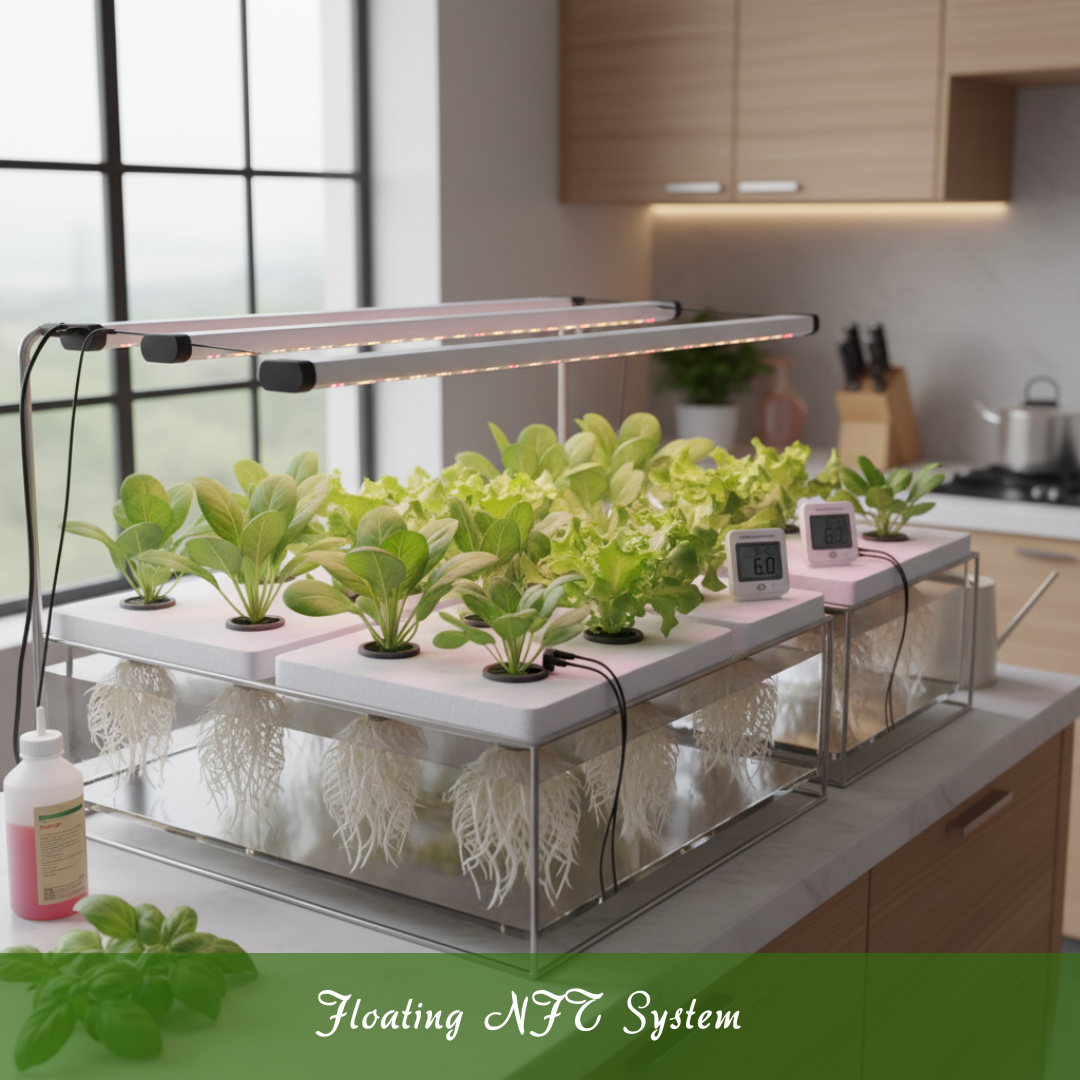
6. Deep Channel NFT System
NFT hydroponic systems with deep channels provide extra root space and oxygenation, making them ideal for larger leafy greens and small commercial setups.
It performs best in moderate to warm climates, between 65 and 85°F. Channels are broader and deeper than standard setups, allowing more root growth and better oxygenation.
Costs typically start around $500–$1,200 for small to mid-scale systems, making it moderately priced for serious hobbyists or small commercial growers.
Setup Process
Start by installing wide, deep channels on a sturdy frame at a slight slope to allow smooth nutrient flow. Position a central reservoir below the system and install a submersible pump to deliver nutrient solution to the top of each channel.
Drill evenly spaced holes in the channel lids for net pots. Fit tubing to return nutrient solution from the channel bottoms back to the reservoir. Add an air pump with airstones for oxygenation to prevent stagnation.
Ensure the structure is well-supported to handle the added water volume. Run a test cycle to check the flow before adding seedlings.
Turn Your Passion for Nature Into Income
🌿 Whether you love gardening, caring for animals, or exploring holistic living,
You can share your knowledge online and earn from it.
Discover how nature lovers are growing their passions into meaningful, income-generating blogs. 👇
Growing Process
Install deeper channels at a slight slope to ensure smooth nutrient flow from the reservoir back to the pump. Place a submersible pump in a reservoir and connect tubing to feed nutrient solution to the top of each channel.
Seedlings germinated in rockwool or clay pebbles are inserted into net pots. Nutrient solution flows constantly, bathing roots while oxygen reaches deeper sections. Daily checks of pH and EC maintain optimal conditions.
Channels should be cleaned weekly to prevent algae buildup. Leafy greens and small herbs are ready to harvest in 35–50 days, allowing continuous planting cycles.
Best Crops
Lettuce, kale, spinach, basil, cilantro, arugula, and Swiss chard.
Pros
Deep channels reduce root crowding and improve oxygen availability, supporting faster plant growth and healthier roots. They are suitable for a broader range of leafy greens and small herbs.
Nutrient distribution is more even, minimizing stress on plants. The system is durable, efficient, and allows higher yields per channel compared to shallow setups.
Cons
Deeper channels require more water and careful monitoring to prevent stagnation. Pump failure can affect a larger volume of plants.
Heavy fruiting crops are still not the best; they require more room, and it is more costly to put up than conventional systems. Cleaning must be done regularly to avoid obstructions and algae.

7. Recirculating NFT System
The recirculating NFT system is designed for efficiency and water conservation, ideal for commercial or urban farms. It works best in controlled climates between 65 and 80°F, where temperature and nutrient solution can be closely managed.
Nutrient solution flows through multiple channels in a closed loop and returns to a central reservoir. It is a moderate to high investment for commercial producers, with costs ranging from $1,000 to $5,000, contingent on system size and complexity.
Setup Process
To set up a recirculating NFT system, connect multiple growing channels to a central reservoir in a closed loop. Place the reservoir beneath the system and install a powerful submersible pump to circulate nutrient solution to the upper ends of the channels.
Fit tubing to carry runoff back to the reservoir for reuse. Drill evenly spaced holes in the channels for net pots. Add aeration stones inside the reservoir to oxygenate the solution.
Use durable piping and connectors to minimize leaks. Check that the flow is consistent across all channels. Run a trial cycle to balance pH and flow before planting.
Growing Process
Set up channels connected to a central reservoir with a submersible pump circulating nutrient solution in a closed loop. Seedlings are germinated in rockwool or clay pebbles before placement in net pots.
The thin nutrient film constantly nourishes roots while oxygen remains available. Monitor pH daily, keeping it between 5.5 and 6.5, and maintain EC within the recommended range: clean channels and reservoirs weekly to prevent blockages or algae growth.
Crops can be harvested once leaves are mature, usually in 30–50 days, and new seedlings can be added for continuous production, ensuring maximum efficiency and yield.
Best Crops
Lettuce, spinach, kale, arugula, basil, cilantro, mint.
Pros
Recirculating NFT systems are highly water-efficient and reduce nutrient waste by continuously reusing the solution. They provide uniform nutrient distribution and consistent growth across all channels.
The system is scalable and supports continuous harvesting. It minimizes labour for watering and monitoring while maintaining healthy root zones and high-quality crops.
Cons
Pump or system failure can affect all connected channels, risking entire crops. Maintenance is more complex, requiring careful monitoring of nutrient levels, pH, and EC.
Initial setup costs are higher, and contamination can spread quickly. Regular cleaning is essential to prevent algae, clogging, and nutrient imbalances.

8. Hybrid NFT System
NFT hydroponic systems that use a hybrid approach combine channels with other methods, allowing growers to cultivate a wider variety of crops efficiently. It works best in moderate climates of 65–80°F or controlled indoor farms.
Costs are higher, ranging from $1,500 to $7,000, depending on system complexity and automation, making it suitable for serious hobbyists or commercial growers.
Setup Process
Begin by designing a layout that combines NFT channels with drip lines or aeroponic nozzles, depending on crop needs.
Install slightly sloped NFT channels connected to a central reservoir with a submersible pump to circulate nutrients. Alongside, set up drip emitters or misting units for fruiting crops, linked to the same or secondary reservoir.
Drill holes in channels and secure net pots for leafy greens. Add airstones in reservoirs for oxygenation. Test both flow systems separately, ensuring even nutrient distribution.
Ensure strong structural support for multiple components. Run a complete test cycle before transplanting seedlings into their respective sections.
Growing Process
Install NFT channels alongside drip or aeroponic sections according to crop requirements. Seedlings are started in rockwool or clay pebbles and placed in the appropriate sections.
Nutrient solution flows continuously in NFT channels, while drip or misting systems provide precise nutrients for larger or fruiting plants. Monitor pH daily and maintain EC for each crop type.
Clean channels, drippers, and reservoirs regularly to prevent algae and blockages. Leafy greens and herbs are ready in 30–45 days, while small fruiting crops may take 50–70 days. Multiple crop cycles can run simultaneously, maximizing output and diversity.
Best Crops
Lettuce, spinach, basil, arugula, strawberries, mint, cilantro.
Pros
Hybrid NFT systems offer versatility, supporting both leafy greens and small fruiting crops like strawberries. Nutrient delivery is efficient, and the system allows experimentation with multiple plant types simultaneously.
It maximizes yield and space utilization, is scalable, and combines the benefits of various hydroponic techniques for improved growth and productivity.
Cons
Hybrid setups are more complex and expensive than standard NFT systems. They require careful monitoring of flow, pH, and nutrient levels for different crops.
Maintenance is higher due to multiple components, and failure in one section can impact other crops. Technical knowledge is essential to manage the system effectively.
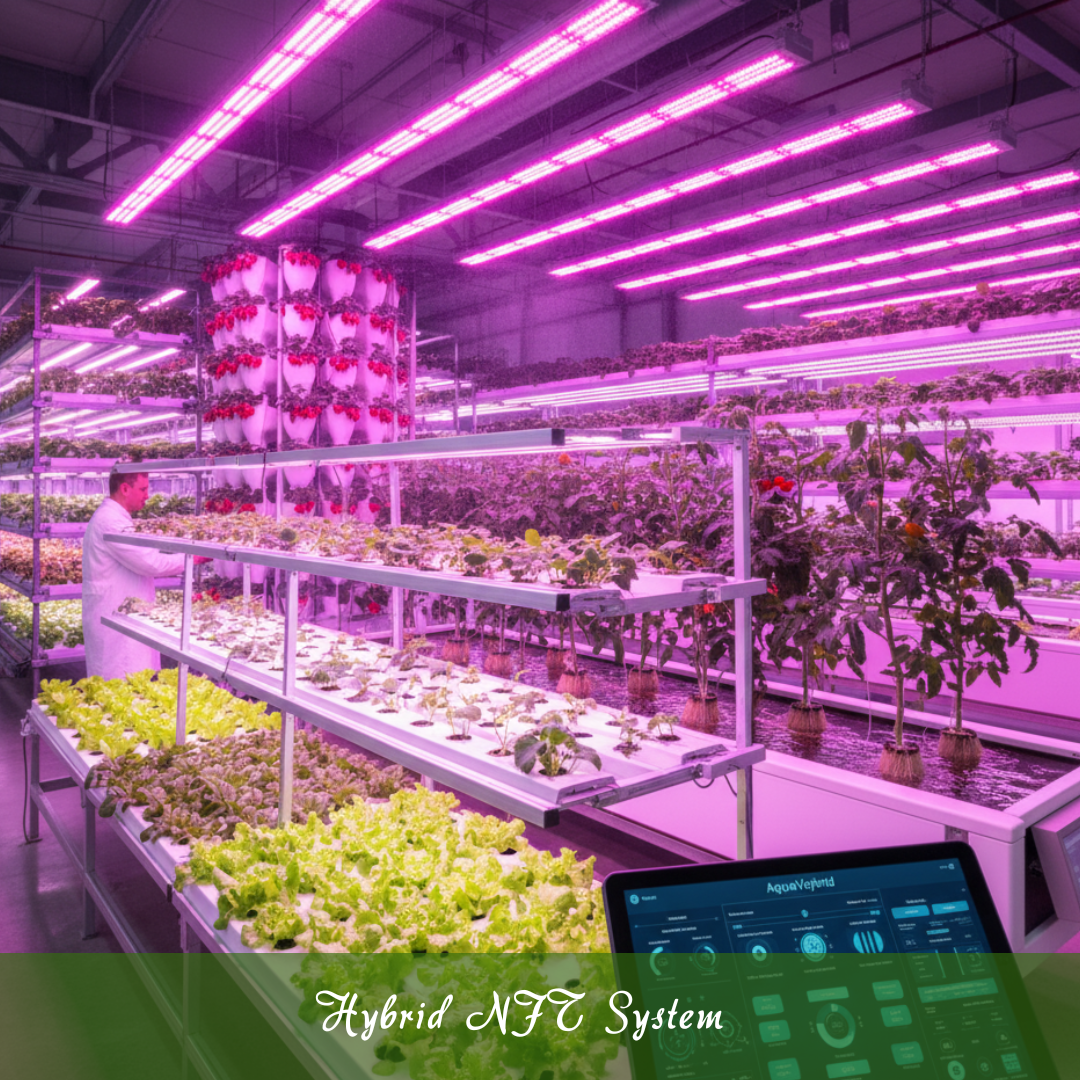
9. Automated NFT System
NFT hydroponic systems with automation provide precise control over nutrients, lighting, and temperature, making them ideal for commercial and high-tech urban farming.
It performs best in controlled climates between 65 and 80°F, where temperature, lighting, and nutrient levels can be monitored digitally.
Costs are higher, ranging from $3,000 to $15,000, depending on the level of automation, sensors, and lighting included.
Setup Process
To set up an automated NFT system, begin with a sturdy frame holding slightly sloped NFT channels that drain into a central reservoir. Install a submersible pump connected to programmable timers for nutrient circulation.
Add pH and EC sensors with digital controllers to adjust solution strength automatically. Integrate supplemental LED grow lights on adjustable timers to ensure consistent exposure across crops.
Place aeration stones in the reservoir to keep nutrients oxygenated. Connect a monitoring system or smart controller for remote tracking.
Test all pumps, sensors, and lights before transplanting seedlings to confirm proper automation and smooth system operation.
Growing Process
Install NFT channels connected to a central reservoir equipped with pumps, sensors, and timers. Seedlings are germinated in rockwool, clay pebbles, or other inert media before transplanting into net pots.
The system automatically circulates nutrient solution, adjusts pH, and monitors EC, ensuring optimal conditions. Supplemental LED lighting can be programmed for uniform exposure.
Daily checks verify sensor accuracy and nutrient levels. Channels and reservoirs are cleaned periodically to prevent algae or blockages.
Leafy greens, herbs, and small fruiting crops can be harvested in 30–50 days, with continuous automated cycles supporting high yield and efficient production.
Best Crops
Lettuce, spinach, basil, arugula, cilantro, kale, mint, strawberries.
Pros
Automated systems reduce labour and human error by controlling nutrient flow, pH, EC, and lighting with sensors and timers. They maintain consistent growth, optimize water and nutrient usage, and improve yield quality.
Continuous monitoring prevents stress and deficiency, making them ideal for large-scale or tech-savvy urban hydroponic operations.
Cons
High initial investment makes it less accessible for beginners. Technical knowledge is required to set up and troubleshoot the system.
Dependence on electronics means power failures or sensor malfunctions can disrupt growth. Maintenance is more complex, and repairing automated components can be costly.
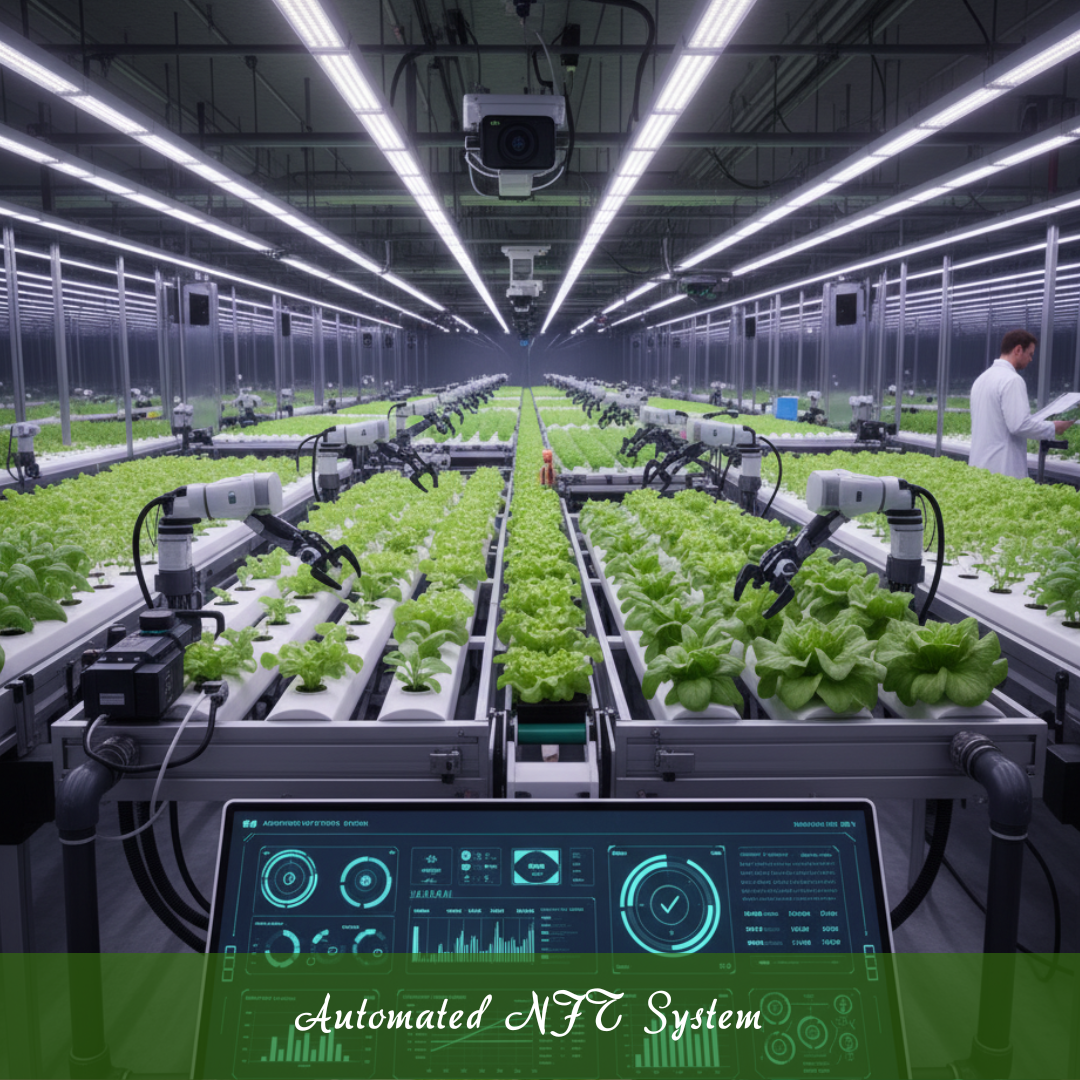
Conclusion
In summary, NFT hydroponic systems offer a modern, efficient, and space-saving way to grow fresh crops year-round. From standard and gully setups to advanced automated or hybrid systems, each type suits different spaces, budgets, and crop choices.
By understanding the pros, cons, and step-by-step growing processes, growers can select the best system for their needs.
With proper care, monitoring, and maintenance, NFT hydroponics provides faster growth, higher yields, and sustainable farming solutions for both hobbyists and commercial growers.
I trust you enjoyed this article on the NFT Hydroponic Systems: Easy Gardening At Home. Please stay tuned for more inspiring guides, helpful tips, and ideas to help you live closer to nature every day.
Take care!
— JeannetteZ
💬 Your Opinion Is Important To Me
Do you have thoughts, ideas, or questions? I’d love to hear from you. Please leave your comments below or email me directly at Jeannette@Close-To-Nature.org.
📚 More Nature-Inspired Reads
Explore more ways to connect with nature, nurture your pets, and live in harmony with the world around you 🌿
